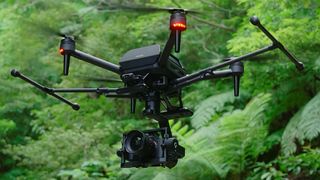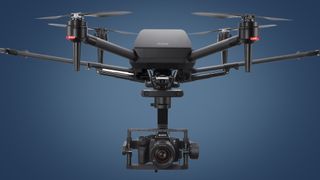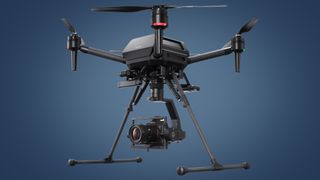Sony Airpeak S1 drone is a DJI rival with a sky-high price tag
The powerful Airpeak has finally landed

The Sony Airpeak S1 drone has just officially taken off in a full launch – and it's promising to be a DJI-beating aerial tool for pro filmmakers.
Sony has been teasing the Airpeak, its first drone, since the project was first announced in November 2020, but it's now released the full specs and price tag of its Alpha-friendly flying machine.
Sony says the Airpeak S1 will be a three-part filmmaking system, consisting of the drone, the Airpeak Flight app (which is, curiously, iOS-only) and the Airpeak Plus cloud service. Of course, the drone itself is the most interesting of these, and the Airpeak S1 has some very impressive specs.
- These are the best drones you can buy right now
- Or check out our guide to the best beginner drones
- Sony Airpeak drone release date, price, rumors and news
Sony says the Airpeak S1 will be able to zip from 0-50mph in just 3.5 seconds, which is 1.5 seconds faster than the equivalent acceleration of the DJI Inspire 2, DJI's fastest drone outside the tiny DJI FPV.
This falcon-like agility is backed up by a top speed of 56mph – while that isn't exactly in racing drone territory, it's pretty nippy for a drone that weighs 2.53kg (including a camera). The Airpeak's weight and four propellors also ensure it'll apparently be stable in winds of up to 44.7mph, which is around twice the resistance of the DJI Inspire 2.

Beyond these specs, Sony is hoping the Airpeak S1's key sell will be its close compatibility with its full-frame Alpha cameras, like the Sony A7S III and Sony A1. These cameras, and their impressive range of G Master lenses across a wide range of focal lengths, certainly promise to produce some spectacular aerial footage, if the Airpeak S1 flies as well as its specs suggest.
While it's previously been possible to use Sony's cameras with other drones using gimbals from DJI and other third-party companies, their integration with Airpeak promises to be much slicker, thanks to features like the new Airpeak Flight app.
Get daily insight, inspiration and deals in your inbox
Get the hottest deals available in your inbox plus news, reviews, opinion, analysis and more from the TechRadar team.
Mission control
Strangely, this app is currently iOS-only with no current plans for an Android version, which seems odd given that Sony Xperia phones run on Google's OS. But Airpeak fliers are more likely to use a tablet like an iPad as their viewfinder, which is where the iOS-only compatibility starts to make more sense.
The Airpeak Flight app and controller will apparently give you separate control over all aspects of the system, including the drone, camera and gimbal. And in another hint at Airpeak's professional filmmaking leanings, a dual operation mode will also allow independent control of the aircraft and gimbal.


We've still only seen short snippets of the Sony Airpeak in flight, so it remains to be seen whether it can match the stability and performance of its DJI rivals in the real world. But Sony is pretty confident that the Airpeak S1's combination of five stereo cameras, two infrared sensors and Sony's Vision Sensing Processor will provide a solid aerial platform for its Alpha cameras.
This combination of in-house processing and sensing power will also apparently allow the Airpeak S1 to maintain stable flight without GNSS satellite location data, which is pretty essential in remote areas.
In fact, one of the only aspects of the Airpeak system that isn't made by Sony is the gimbal, which is instead supplied by a third-party company called Gremsy. It's made a custom version of its three-axis T3 gimbal, which has a handy quick-release system.
Analysis: A Hollywood-level flagship to take Alphas skywards
The Airpeak S1's gimbal isn't included in its final price tag – and if you thought the drone itself looked scary, you should see its MSRP. It's available for pre-order ahead of availability in Fall 2021 (in other words, sometime between September and December) for $8,999 (around £6,350 / AU$11,620). Ouch.
The special custom Gremsy T3 gimbal will apparently have a similar price to the existing version ($1,750, or about £1,235 / AU$2,260) and, of course, you'll need to factor in the cost of a camera, too. Clearly, this is a five-figure system for professional filmmakers and studios, but it's an exciting one all the same.
In the history of aerial filmmaking, the Airpeak S1's price tag is also a relative pittance. The kind of full-frame cinematography and photos it promises would have, less than a decade ago, only been possible with a helicopter.
While helicopters are able to fly at higher altitudes and don't have any battery life concerns – the Airpeak S1 has a relatively limited 12-minute flight time when carrying a camera, or 22 minutes without – drones are much more affordable and agile, which gives filmmakers greater creative flexibility.
With Sony now something of a movie and TV powerhouse, you can bet that Airpeak will be behind some spectacular shots in its upcoming films, which include the likes of Uncharted and Morbius.

What about an Airpeak drone for hobbyist fliers? The fact that Sony has given the Airpeak S1 a model number suggests it could ultimately be part of a range. But given that Sony is focusing its photographic efforts on full-frame Alpha cameras, it seems likely that its Airpeak project will remain similarly high-end.
Drones like the DJI Air 2S, Skydio 2 and rumored DJI Mavic 3 Pro already have the consumer drone market pretty sewn up, and the margins are likely too slim for Sony to compete in that space, given its lack of heritage in areas like gimbals. Still, we're certainly looking forward to seeing the Airpeak S1 in action and also where the system flies to next.
- Read our in-depth DJI Air 2S review

Mark is TechRadar's Senior news editor. Having worked in tech journalism for a ludicrous 17 years, Mark is now attempting to break the world record for the number of camera bags hoarded by one person. He was previously Cameras Editor at both TechRadar and Trusted Reviews, Acting editor on Stuff.tv, as well as Features editor and Reviews editor on Stuff magazine. As a freelancer, he's contributed to titles including The Sunday Times, FourFourTwo and Arena. And in a former life, he also won The Daily Telegraph's Young Sportswriter of the Year. But that was before he discovered the strange joys of getting up at 4am for a photo shoot in London's Square Mile.